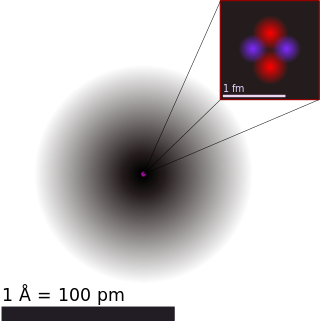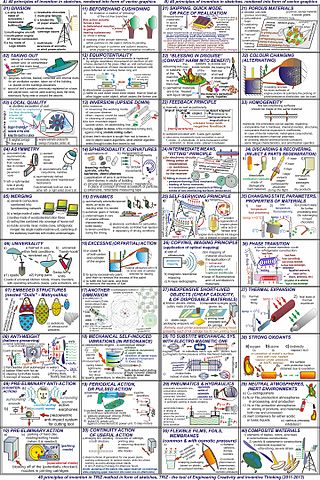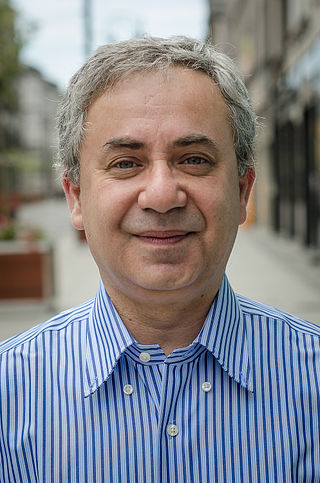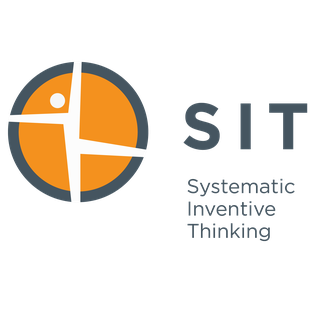
Atomic theory is the scientific theory that matter is composed of particles called atoms. The concept that matter is composed of discrete particles is an ancient idea, but gained scientific credence in the 18th and 19th centuries when scientists found it could explain the behaviors of gases and how chemical elements reacted with each other. By the end of the 19th century, atomic theory had gained widespread acceptance in the scientific community.
Complexity characterises the behaviour of a system or model whose components interact in multiple ways and follow local rules, leading to nonlinearity, randomness, collective dynamics, hierarchy, and emergence.

Entropy is a scientific concept, as well as a measurable physical property, that is most commonly associated with a state of disorder, randomness, or uncertainty. The term and the concept are used in diverse fields, from classical thermodynamics, where it was first recognized, to the microscopic description of nature in statistical physics, and to the principles of information theory. It has found far-ranging applications in chemistry and physics, in biological systems and their relation to life, in cosmology, economics, sociology, weather science, climate change, and information systems including the transmission of information in telecommunication.

Electric power transmission is the bulk movement of electrical energy from a generating site, such as a power plant, to an electrical substation. The interconnected lines that facilitate this movement form a transmission network. This is distinct from the local wiring between high-voltage substations and customers, which is typically referred to as electric power distribution. The combined transmission and distribution network is part of electricity delivery, known as the electrical grid.
TRIZ is an approach that combines an organized and systematic method for problem solving with analysis and forecasting techniques derived from the study of patterns of invention in the global patent literature. The development and improvement of products and technologies in accordance with TRIZ are guided by the objective laws of technical systems evolution, forming the basis for TRIZ problem solving tools and methods. It was developed by Genrich Altshuller, a Soviet inventor, and science-fiction author, along with his colleagues, starting in 1946. In English the name is typically rendered as the theory of inventive problem solving, and occasionally goes by the English acronym TIPS.

The emission spectrum of a chemical element or chemical compound is the spectrum of frequencies of electromagnetic radiation emitted due to an electron making a transition from a high energy state to a lower energy state. The photon energy of the emitted photon is equal to the energy difference between the two states. There are many possible electron transitions for each atom, and each transition has a specific energy difference. This collection of different transitions, leading to different radiated wavelengths, make up an emission spectrum. Each element's emission spectrum is unique. Therefore, spectroscopy can be used to identify elements in matter of unknown composition. Similarly, the emission spectra of molecules can be used in chemical analysis of substances.
An energy carrier is a substance (fuel) or sometimes a phenomenon that contains energy that can be later converted to other forms such as mechanical work or heat or to operate chemical or physical processes.

Computational sociology is a branch of sociology that uses computationally intensive methods to analyze and model social phenomena. Using computer simulations, artificial intelligence, complex statistical methods, and analytic approaches like social network analysis, computational sociology develops and tests theories of complex social processes through bottom-up modeling of social interactions.
From a scientific and engineering perspective, second-law based exergy analysis is valuable because it provides a number of benefits over energy analysis alone. These benefits include the basis for determining energy quality, enhancing the understanding of fundamental physical phenomena, and improving design, performance evaluation and optimization efforts. In thermodynamics, the eXergy of a system is the maximum useful work that can be produced as the system is brought into equilibrium with its environment by an ideal process. The specification of an 'ideal process' allows the determination of 'maximum work' production. From a conceptual perspective, exergy is the 'ideal' potential of a system to do work or cause a change as it achieves equilibrium with its environment. Exergy is also known as 'availability'. Exergy is non-zero when there is dis-equilibrium between the system and its environment, and exergy is zero when equilibrium is established.
Unified Structured Inventive Thinking (USIT) is a structured, problem-solving methodology for finding innovative solution concepts to engineering-design type problems. Historically, USIT is related to Systematic Inventive Thinking (SIT), which originated in Israel and is related to TRIZ, the Russian methodology. It differs from TRIZ in several ways, but most importantly it is a simpler methodology, which makes it quicker to learn and easier to apply. It requires no databases or computer software.

The 40 Principles of invention are a suite of ideas that purport to aid in solving hard technical problems.
Membraneless Fuel Cells convert stored chemical energy into electrical energy without the use of a conducting membrane as with other types of Fuel Cells. In Laminar Flow Fuel Cells (LFFC) this is achieved by exploiting the phenomenon of non-mixing laminar flows where the interface between the two flows works as a proton/ion conductor. The interface allows for high diffusivity and eliminates the need for costly membranes. The operating principles of these cells mean that they can only be built to millimeter-scale sizes. The lack of a membrane means they are cheaper but the size limits their use to portable applications which require small amounts of power.
Transition management is a governance approach that aims to facilitate and accelerate sustainability transitions through a participatory process of visioning, learning and experimenting. In its application, transition management seeks to bring together multiple viewpoints and multiple approaches in a 'transition arena'. Participants are invited to structure their shared problems with the current system and develop shared visions and goals which are then tested for practicality through the use of experimentation, learning and reflexivity. The model is often discussed in reference to sustainable development and the possible use of the model as a method for change.
Technological transitions (TT) can best be described as a collection of theories regarding how technological innovations occur, the driving forces behind them, and how they are incorporated into society. TT draws on a number of fields, including history of science, technology studies, and evolutionary economics. Alongside the technological advancement, TT considers wider societal changes such as "user practices, regulation, industrial networks, infrastructure, and symbolic meaning or culture". Hughes refers to the 'seamless web' where physical artifacts, organizations, scientific communities, and social practices combine. A technological transition occurs when there is a major shift in these socio-technical configurations.
Systematic Inventive Thinking (SIT) is a thinking method developed in Israel in the mid-1990s. Derived from Genrich Altshuller's TRIZ engineering discipline, SIT is a practical approach to creativity, innovation and problem solving, which has become a well known methodology for innovation. At the heart of SIT's method is one core idea adopted from Genrich Altshuller's TRIZ which is also known as Theory of Inventive Problem Solving (TIPS): that inventive solutions share common patterns. Focusing not on what makes inventive solutions different – but on what they share in common – is core to SIT's approach.

Greg Yezersky is an American engineer, consultant and university lecturer, the creator of the General Theory of Innovation (GTI).
This glossary of electrical and electronics engineering is a list of definitions of terms and concepts related specifically to electrical engineering and electronics engineering. For terms related to engineering in general, see Glossary of engineering.
Advanced Innovation Design Approach (AIDA) is a holistic approach for enhancing the innovative and competitive capabilities of industrial companies. The name Advanced Innovation Design Approach (AIDA) was proposed in the research project "Innovation Process 4.0" run at the University of Applied Sciences Offenburg, Germany in co-operation with 10 German industrial companies in 2015–2019. AIDA can be considered as a pioneering mindset, an individually adaptable range of strong innovation techniques such as comprehensive front-end innovation process, advanced innovation methods, best tools and methods of the theory of inventive problem solving TRIZ, organisational measures for accelerating innovation, IT-solutions for Computer-Aided Innovation, and other tools for new product development, elaborated in the recent decade in the industry and academia.

S.I.T Systematic Inventive Thinking LTD. is a privately owned innovation company. Founded in Tel Aviv, Israel in 1995, it now has offices/affiliates in the UK, Australia, Chile, China, and Colombia.
In TRIZ, inventive standards are a set of rules of synthesis and transformation of technical systems directly resulting from laws of evolution of these systems. As a rule, solving of a complex inventive problem is addressed to a combination of at least one TRIZ method and physical effect. Based on frequently used combinations of TRIZ methods and physical effects Genrich Altshuller proposed inventive standards.







